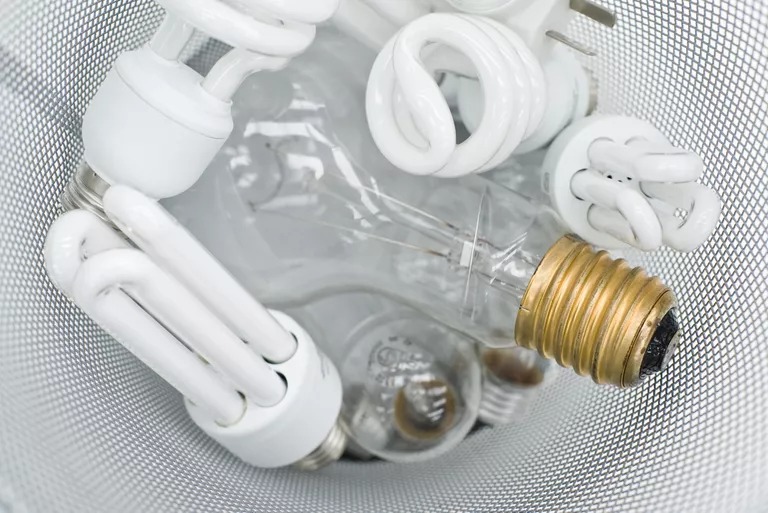Recycling Light Bulbs
Every state & municipality has its own criteria & recycling programs in place. All the type of light bulb is recycled in a unique way. While your recycling program for curbside pickup might accept LED bulbs, it usually won’t accept incandescent or CFL bulbs that could contain harmful chemicals. There are dedicated recycling programs for these products in many states.
Incandescent Light Bulbs

An incandescent light bulb consists of a glass enclosure containing a filament typically made from tungsten, a metal with a high melting point. When you turn an incandescent light bulb on, a current passes through the filament and heats it until it’s white-hot and produces visible light.
Because they have a low manufacturing cost, work well on either alternating or direct electrical currents, and are compatible with devices like dimmers and timers, incandescent bulbs are popular for use in both household and commercial lighting. They’re often used in car headlamps and flashlights as well because they work both indoors and outdoors.
The bipartisan Energy Independence and Security Act of 2007 established efficiency standards that required bulbs to use about 25% less energy.3 While that didn’t necessarily ban incandescent bulbs, most were phased out of production. Today, incandescent bulbs are not as common as other types of light bulbs, but they aren’t unheard of.
These types of light bulbs can be difficult to recycle because they contain small amounts of metal and glass that aren’t easily separated from one another. Many recyclers won’t accept incandescent light bulbs because the energy required to recycle them is not worth the salvaged material.
That said, you can find recycling programs that accept incandescent light bulbs with some digging. Check with the recycling facility near you to determine if they accept the material or consider a mail-in program.
Incandescent bulbs are difficult to recycle. Which is why you may have to resort to throwing your old ones away when you switch to a more efficient light source, like LED. They don’t contain any hazardous chemicals, but to minimize waste that reaches a landfill, avoid buying these types of bulbs.
CFLs

Compact fluorescent light bulbs, or CFLS, are preferred over incandescent lights. It is because they use less energy and available in a range of shapes and colors. They are the preferred bulbs for use in public structures, businesses, schools, and hospitals all throughout the world. An electric current flows through a tube containing argon and mercury when it is turned on, visible light is produced.
CFLs may be more environmentally beneficial than some other types of bulbs, but they aren’t always. Mercury, which is hazardous to both humans and animals, is found in CFLs.
These kinds of bulbs shouldn’t be thrown away because they are dangerous. Even some local governments forbid the disposal of fluorescent bulbs, leaving recycling as the only choice.
The EPA advises people to utilize neighborhood CFL recycling programs as opposed to throwing them in with household trash. 2 CFL bulbs can be recycled at a number of stores, including Bartell Drugs, Lowe’s, and Home Depot.
The glass, metals, and other components of CFLs are recycled and then used to create new goods. The glass casing and aluminum components of the CFL are broken down by a bulb recycler using specialized machinery. The mercury can be used again in fresh bulbs or in items like thermostats. While the aluminum is recycled and used as scrap metal, the glass is transformed into materials like concrete or tile.
Recycling CFLs not only keeps garbage out of landfills but also stops the discharge of hazardous mercury into the environment. For information about recycling possibilities in your area, get in touch with your local waste collection company.
LED Light Bulbs

Light-emitting diode (LED) light bulbs are a high-efficiency lighting solution. It can provide light up to 90% more effectively than incandescent bulbs. 6 Additionally, they are more effective than CFL bulbs. About 30 times longer than incandescent bulbs and 5 times longer than a standard CFL, LED light bulbs have a lifespan of up to 50,000 hours.
When electricity flows through a microchip in an LED bulb, the microchip activates a light source to create visible light. The heat that the LEDs generate is dissipated by a heat sink, keeping the bulbs cool to the touch.
LED light bulbs are the most environmentally friendly bulbs on the market right now. Thanks to their extended lifespan, lack of dangerous chemicals, and is energy efficient. It is trending today 9 Additionally, they are quite recyclable. There are recycling containers inside several big box retailers, including IKEA and Lowe’s, where you may dispose of old LED bulbs. Some cities provide comparable services. To find out if they accept them, get in touch with the waste management company in your area or a nearby big box retailer.
LED light bulbs are put through a shredder as the initial step in the recycling process, which separates their components. Depending on the facility, the individual bits of glass and metal are next processed by separators or magnetic sorters. LED lights’ most expensive parts are their metal ones, therefore
Also Read – Is Bubble Wrap Recyclable?



